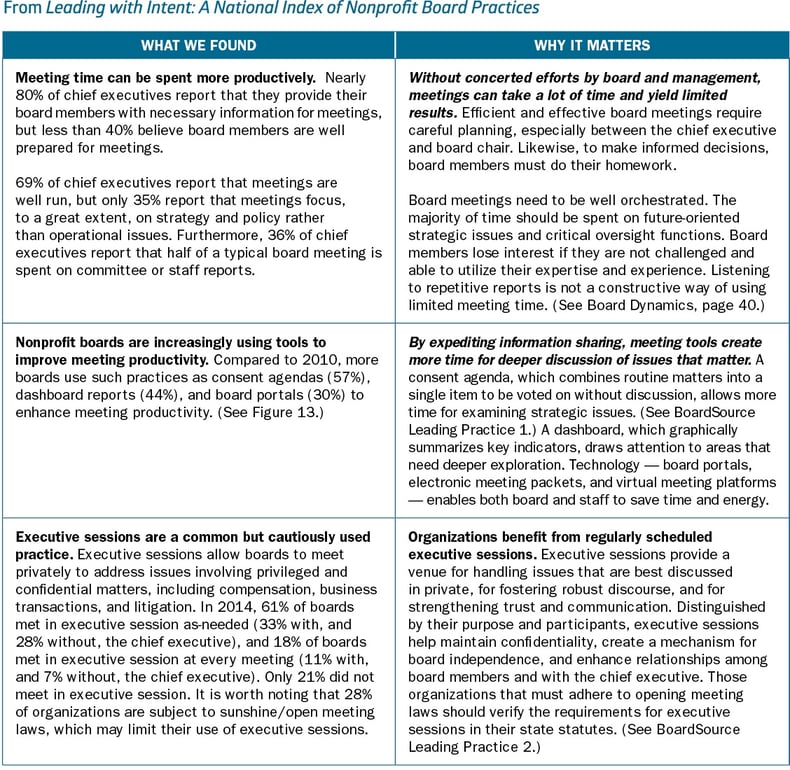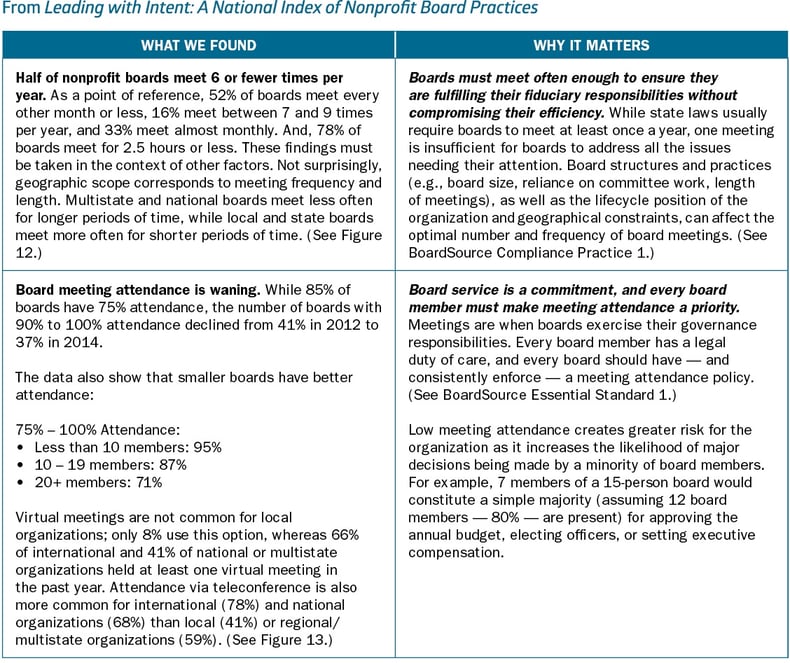The board meeting was only at the 30-minute mark, but eyes were already starting to droop. The AC was out, and the small fans whirred in the background like a white noise machine. Prior to the meeting, board members were treated to a 4-course lunch, and the rich food was adding to the sleepiness. There were two board members calling in, and sound issues caused their voices to be muted and fuzzy. The board chair looked around the room and wondered if it was worth addressing the important issues later in the agenda. How could they get meetings back on track?
Let’s be frank: board meeting logistics are not fun. Not even close. But they are important to pay attention to if you want your board meeting to have a maximum impact. Logistical details can often make or break a board meeting. Think about it. Have you ever lost focus during a meeting because it was too cold (or too hot)? Or because you were hungry? No one can focus on budgets when it’s been hours since his or her last meal. What about missing a meeting due to personal conflicts or being out of town?
Choosing the right date, time, and location is important to ensure sufficient attendance, and paying attention to the smaller details, such as meeting length, the meeting room, and feeding the board, is important to ensure that the materials you have worked so hard on can be received by attentive and engaged board members.
There are several aspects of board meetings logistics and they essentially boil down to where, when, and how the meeting will take place.
Where
For organizations with a broader geographical reach (such as national or international organizations), consider the following when selecting a board meeting location:
- How much are board members investing (in time and money) to get there?
- Are there certain members who benefit more than others (or are significantly more burdened than others) in having the meeting at this location?
- Can the meeting be held in your offices, or does an off-site space need to be obtained? If renting out a space, factor this into your board meeting costs.
- Can one of your meetings be held virtually? This may save board members (and the organization) time and money.
If you always hold your meeting in the same place, think about changing your location every so often to accommodate board members who are further away and to increase attendance. If you change your meeting location, be sure to give your members plenty of notice. You can and should use off-site meetings as an opportunity to have “mission moments” that demonstrate the organization’s impact.
For regional or local organizations, the question of “where” is more about whether the meeting is on-site or off-site. If you have conference space available at your office, hosting the board meeting can be beneficial as it allows the opportunity for staff to meet the board. If you do not have conference space, think creatively. Where can you meet so that the board members can get closer to the mission and to where your daily work has an impact? Potential off-site meeting locations include: hospitals, schools, museums, libraries, or the facilities of a major funder.
When
Board members are very busy people, and finding dates and times that work for everyone can be quite the challenge. To get the maximum turnout, try to schedule meetings at least a year in advance. The more notice you can give your board members, the better. Not a master scheduler? Try an online resource, such as Doodle, to allow members to select the times that work best for them. Pay attention to religious holidays and major vacation periods, and think about what kind of commitments your board members have. Do they have full time jobs? Are they students? Do they have families to take care of? All of these factors may impact the times they are available. Lastly, be sure to get feedback from your board about generally what works best for them. You will not be able to accommodate everyone, and some members will have to make compromises. Think about alternating the timing to accommodate different members. If some members are not as able to compromise, stick with the schedule that accommodates the majority to ensure maximum attendance. Don’t forget to solicit additional feedback as time goes by, as the composition of your board changes.
How
Whether it’s a cold room, an awkward table set up, or hunger pangs; the smallest details can impact the attentiveness of board members at a meeting. Remember, they are human after all. Plan ahead so that once your board members are physically at the meeting, they can stay actively engaged in the conversation.
Meeting Length
If a board meeting is too short, members may feel like their time is being wasted and important items are missed. If it is too long you may lose momentum and attention towards the end. To ensure your meeting length is just right, consider the following:
- How often does the board meet?
If you meet monthly, normal meetings may only last an hour. However if you only meet a few times a year, meetings could take a full day (or more). It’s important to regularly evaluate your meeting frequency and length to ensure that there is sufficient time to address all of the work.
- What is the purpose of the meeting?
Annual retreats and other special meetings might need to be longer than normal board meetings.
- Is the agenda appropriate?
The agenda determines the length of the meeting, so be sure that everything on the agenda is necessary. To save time for strategic discussions, adopt a consent agenda (a compilation of items that the board approves with one vote).
- Is the board chair a skilled facilitator?
It is the board chair’s role to lead and facilitate the meeting. He/she should be able to keep the discussion focused, follow the agenda, respect the predetermined length of the meeting, and keep everyone appropriately engaged.
- Do board members do their homework?
Coming well prepared to board meetings is not only an essential board responsibility, but helps board meetings run smoothly. It is important for staff to make sure board materials are sent out (or available on an online portal) with sufficient time (at least one week) for board members to prepare.
Meeting Room
There is a reason that a broad rectangular table setup is known a boardroom table. This set up is considered ideal for facilitating productive conversation. The board chair should be seated at the head of the table to better facilitate discussion, and the chief executive should sit next to him or her. This will help the board chair and the chief executive to build their partnership. It may be a good idea to assign seats for the rest of the board members as well, although be sure to switch it up for each board meeting to encourage interaction among the board. Potential attendees with no role in the meeting should be seated on the periphery, while guest speakers should be invited to sit with the board.
Test the meeting room for comfort and functionality issues before the meeting starts. Remember, the board members will be sitting in this room for several hours- anything you can do to maximize their comfort will be sure to improve the overall meeting experience.
Food
Whether food should be provided at a board meeting is determined by the timing of the meeting. If it starts before 10:30 in the morning, it is a good idea to provide at least a light breakfast. Serving lunch is a must if the meeting runs through noon. If you do a board dinner, think about doing it the night before the meeting and invite the senior staff. This is a great way to foster relationships between the board and staff and set the mood for the following day.
Make sure to survey board members so you are aware of any food allergies or restrictions. Keeping this information on file with other board member demographics will make planning just that much easier.
If you want to be widely praised for your hosting skills, the key is to remember the little things. Think about the where, the when and the how. Remember that your board members are volunteers, and they have time commitments and basic needs just like the rest of us.
Looking for more information on Board Meetings?




